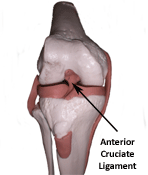|
Conditions & Treatments - Anterior Cruciate Ligament (ACL) Sprain/Tear |

The anterior cruciate ligament is a sturdy band of fibrous connective tissue (ligament) which connects the bottom portion of the posterior thigh bone (medial aspect of the lateral femoral condyle) to the anterior top portion of the lower leg bone (anterior intercondylar area of the tibia). Its function is to promote stability at the knee by minimizing the thigh bone (femur) from displacing forward while the lower leg is planted on the ground. It is often injured with activities which require twisting motions at the knee, hyperextension of the knee, planting of the lower leg while stopping/cutting suddenly, or sustaining a blow to the lower leg when the lower leg is planted on the ground. When the ACL is injured, pain and swelling is often experienced at the knee. A loud pop, which is usually associated with a tear, can usually be heard as well. To determine the degree of severity of damage to the ACL your physical therapist or physician can perform tests and classify your ACL injury into three categories:
Type I ACL sprain: the ligament is stretched but not torn Type II ACL sprain: there is mild looseness or laxity at the knee with partial tear of the ligament Type III ACL sprain: the joint is very loose and unstable because the ligament is completely torn. Given an individual’s functional demands, surgery is often the option for an ACL tear for those individuals who participate in high level physical activities such as athletics. For those individuals that don’t undergo surgery for an ACL tear, performing an exercise program which incorporates strengthening/stabilization is extremely important to minimize buckling at the knee and to maximize function. |
ACL Sprain/Tear Treatment Options for a PT
· (PRICE) Protect, Rest, Ice, Compress, Elevate
· AROM or gentle PROM exercises (see videos 16 & 21 for knee)
· Strengthening/Stabilization (see videos 17, 18, 20, 23 for knee)
· Somatosensory/Proprioceptive Training
· Obtain a knee brace
| Comment - Message Board |
Last revised: January 17, 2008
by Chai Rasavong, MPT
|
|
|
|





